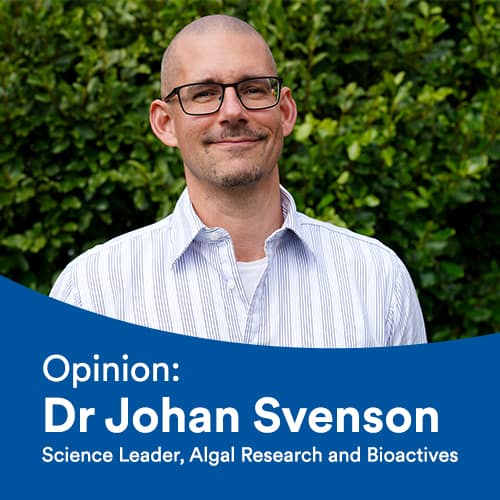Opinion: Dr Johan Svenson on Cawthron’s approach to researching ‘methane-busting’ Asparagopsis & growing it at scale
04 March 2021
Cawthon Institute is one of many organisations in New Zealand and abroad currently researching pilot-scale production of the seaweed Asparagopsis armata, which has been proven in overseas trials to reduce greenhouse gas emissions in livestock by over 90 percent when used as supplementary feed.
I was pleased to be interviewed for a One News story recently about the exciting potential of Asparagopsis and also some of the challenges that we’re trying to tackle so we can grow it at the scale required to make a real-world impact. We’re going to need a lot of it! Farmers have been optimistically open-minded so far – if the industry can produce a safe, reliable, affordable product, they’re definitely interested.
In 2019 Cawthron received $100,000 from the government’s Sustainable Food and Fibre Futures fund to support the development of an early proof of concept of the aquaculture production systems needed to develop Asparagopsis at scale. Cawthron has continued to independently fund this research programme and is currently in discussions with prospective government and industry partners about future directions for this research.
One thing that was clear to Cawthron from the very start of our Asparagopsis research programme is that wild harvest was not likely to provide a reliable ongoing supply of Asparagopsis for livestock. Essentially, there are two core approaches you can take for the first stage of developing farming methods in aquaculture. One is to use wild stock, harvesting and transplanting juveniles or seed, and using them to ongrow within farming systems.
The the other is to close the life-cycle in the laboratory so you can produce seed any time of year, reliably, and you know exactly what you are growing.

Cawthron is committed to the latter approach. It may take longer at the early stages of research, but it gives us a better shot at achieving our goal which is to supply a fledgling New Zealand Asparagopsis industry with high-quality, reliable domesticated seed stock and support the development of efficient, large-scale aquaculture farming systems, including understanding harvest cycles and optimal farming locations etc.
Our research helped to revolutionise the mussel industry through the development of selective breeding and sustainable aquaculture farming methods, and our goal is to do the same with seaweed.
The Government has set a target of growing New Zealand’s industry to $3bn by 2035, however we think there is potential for much greater growth in revenue and that this can be accelerated if the industry is able to attract the levels of investment required to fund new ventures and expand capability.
With Government support, Cawthron is investing a huge amount into seaweed research. In May this year we will open the PGF-funded National Algae Research Centre at the Cawthron Aquaculture Park in Nelson – a research facility that will expand our internationally recognised work in the rapidly growing algae sector and create value for existing and new partners by creating a bridge from science to industry. We are also doing research that will support the development of New Zealand’s blue economy sector and investigating the nutritional potential of seaweed as a future food.
There is a lot of momentum behind seaweed R&D in New Zealand at present and Cawthron is there in the mix alongside industry, Government, iwi and other research organisations, driving progress and innovation that will help to build a better future for Aotearoa. I look forward to sharing more with you about our progress over the coming months.